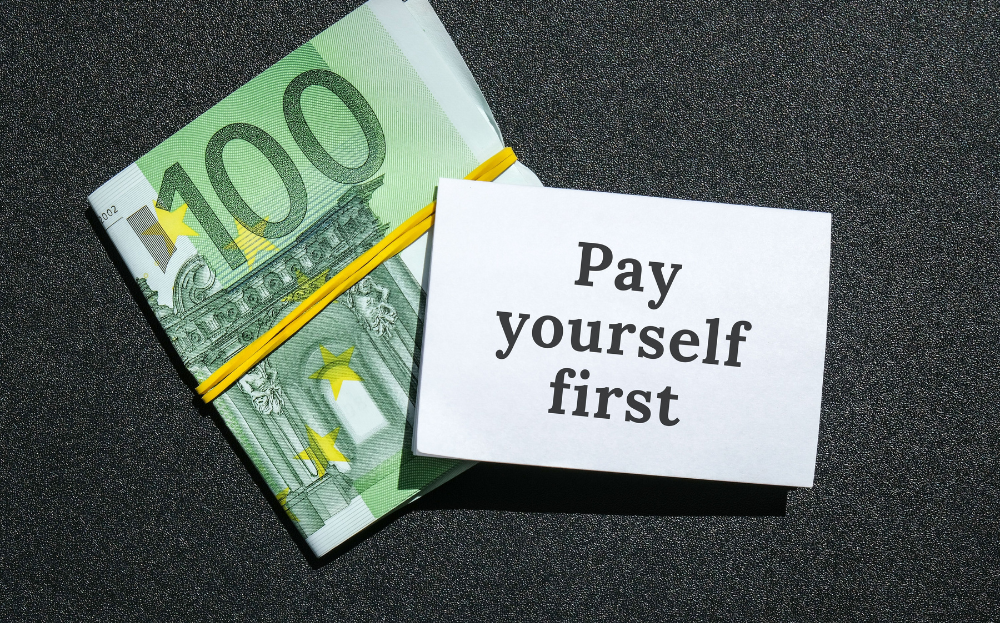Pay Yourself First is not about being stingy or holding back on enjoying life. It’s about putting the future as a priority, and making yourself the first person who deserves to be rewarded every time you work hard.
Maybe when you just got paid, the first thing you do is checkout the coveted items that have long been in the online shopping cart. Or rush to pay electricity bills, rent, and monthly installments.
All of these habits are valid. We all need to enjoy the fruits of our labor and keep our spirits up. But, among the various expenses that you prioritize, there is one important habit that is often forgotten even though it has a huge impact in the long run. That habit is Pay Yourself First.
What is Pay Yourself First?
Pay Yourself First is a financial principle that means setting aside money to save or invest first every time you receive income, before using it for other needs such as paying bills, shopping, or entertainment.
Unlike the common habit of saving from leftover expenses, this concept flips the mindset of “savings is not a leftover, it’s a priority.”
Why is Pay Yourself First Important?
1. Making the Future a Priority
When you apply Pay Yourself First, you put yourself in this case your future version as the top priority. It’s no longer a matter of “if there is something left over, then save it”, but rather “save first, then use the rest”. This way, you are investing in your financial security and comfort in the future.
2. Build Healthy Financial Habits
Many times we are trapped in a consumptive lifestyle just because we feel “there is still money in the account.” Setting aside savings at the beginning helps limit the money you can use, indirectly regulating your spending patterns to be wiser.
3. Have Emergency Fund and Dream Savings
One of the positive impacts of Pay Yourself First is that you are better prepared for unexpected situations ranging from job loss, sudden medical needs, to business opportunities that come unexpectedly. In addition, dreams such as vacations, new gadgets, or dream homes can be achieved faster because you set aside money consistently.
How to Apply Pay Yourself First
1. Determine the amount to set aside
Start with a fixed percentage of your income. For example, 10% of your salary, or a number that is comfortable and realistic for you. If you still find it hard, it’s okay to start with Rp100,000 per month. The important thing is to be consistent.
2. Use Separate Accounts
Separate your savings/investment account from your day-to-day account so you won’t be tempted to use it. Think of it as “money that should not be touched.”
3. Automate the Process
Use the auto-debit feature so that funds are immediately deducted and transferred to savings or investment instruments as soon as you receive your salary. This makes you more disciplined because the process is automatic.
4. Set a Goal
Saving without a goal can be boring. So, set a specific target: whether it’s for an emergency fund, down payment for a house, business capital, or retirement fund. A clear goal will make you more enthusiastic.
Simple Scenario Example of Pay Yourself First
Imagine you get a salary of Rp5 million per month. If you apply the Pay Yourself First principle and set aside 10% (Rp500,000) directly into savings or mutual funds, in a year you will have Rp6 million. That does not include potential interest or investment returns.
Without realizing it, that money can be a savior in times of emergency, or become capital when there is a good opportunity. And it all starts with one small step: setting aside money at the beginning, not waiting for the rest.
Pay Yourself First with Treasury
Starting to apply the Pay Yourself First principle is the right first step to building healthy financial habits. One simple and safe way to start is by investing in digital gold.
At Treasury, you can start investing in gold from a small amount, anytime and anywhere, right from the app.
So, instead of spending your money on consumptive things, why not start allocating it to assets that grow in value? Pay yourself first by investing in digital gold at Treasury for a more secure and planned financial future.











